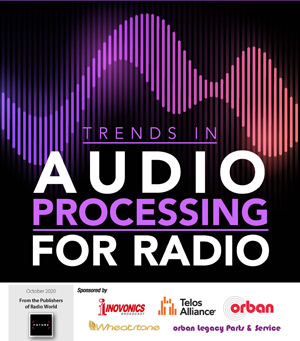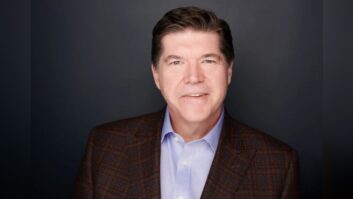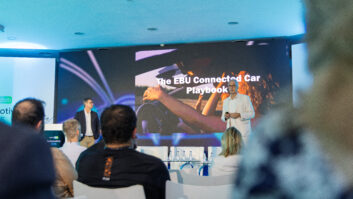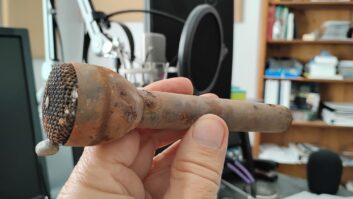 Tom Lawler is a contract studio/RF engineer who builds and maintains analog and AoIP radio and home studios for broadcast; his full-time job is in field technical services for RCS. We spoke to him for the Radio World ebook “Trends in Audio Processing for Radio.”
Tom Lawler is a contract studio/RF engineer who builds and maintains analog and AoIP radio and home studios for broadcast; his full-time job is in field technical services for RCS. We spoke to him for the Radio World ebook “Trends in Audio Processing for Radio.”
Radio World: Tom, what do you see as the most important trend in the design and use of processors?
Tom Lawler: With the development by leaps and bounds in flexibility — between insert patch points for ratings watermarking, multimode boxes, as well as being able to do MPX over AES or AoIP — modern processors have become virtual Swiss Army knives. Not to mention that devices like StreamBlade from Wheatstone or software processors like StereoTool let your online presence have just as much punch as the OTA signal.
It wasn’t that many years ago where the only option was to try and adapt an FM box or use a PCI card that couldn’t be easily updated.
RW: What should readers know about the differences in processing needs for analog over the air, digital OTA, podcasts and streaming?
Lawler: Every medium requires a different approach, but they all require you to have as clean a source material as possible.
With analog OTA you can get away with clipping/limiting to achieve loudness without introducing fatiguing artifacts — but that approach won’t work with digital OTA as artifacts will cause issues with the bit-reduced codec. For podcasting, use a gentle multiband to smooth over transitions between segments/presenters — resist the urge to treat it like FM!
Streaming can be treated like FM, but make sure to use lookahead limiting instead of clipping — also, make sure everything is in-phase for when it’s folded down to mono on a smart speaker.
RW: How will the concepts of the cloud, virtualization and software as a service affect the processing marketplace?
Lawler: I hope that it will lead to greater flexibility, redundancy and better quality. Imagine no STL issues to contend with (as long as your ISPs are up), and you now have the ability to make upgrades with the click of a mouse rather than having to physically rack up gear.
This is a great opportunity for users as well as vendors alike — users gain as much flexibility as they are willing to pay for, and vendors can have a reliable subscription income stream. Plus, there is no single point of failure like in a traditional plant.
RW: The pandemic is changing thinking about the need for big buildings and studios to make good radio. What does this mean for processing?
Lawler: I think COVID-19 will accelerate moving to flexible software/cloud solutions for processing — and it will be more important than ever with the myriad of sources and level differences.
Given that more and more talent is working remotely from home rather than at the studio it will be a challenge to keep everything sounding consistent from source to source. Not every home studio has mic processing, and many automation systems do not handle ducking gracefully.
Adding processing in the cloud will be necessary to keep the audio consistent — more so now than before. This also means less in the racks to power and cool if done right.
RW: How is consumer behavior changing; for instance are younger consumers moving toward greater fidelity?
Lawler: Things have come full circle almost. In the 1950s and ’60s you had a 3-inch mono speaker that went hand-in-hand with the explosion of top 40 radio. And now, we have smart speakers that are about the same size fueling another revolution in how audio entertainment is consumed. Apple and their just released new iPod touting greater fidelity, and the ability to pair them and create stereo, similar to other smart speakers.
If this is how your audience consumes the station/stream/podcast, make sure to give them a download or on-demand stream that is easy to listen to no matter the environment. Make the most of the 3-inch speaker without sounding smashed. Do your content creators have access to the tools to process voice without making it sound unnatural? That is the trick with modern listening — making it pleasing while taking into account less than perfect conditions.
RW: In 2014 we did a story asking if processors had become as powerful as they could get. In 2020, where might further dramatic improvements come from?
Lawler: Never underestimate the ability to go further. My grandfather once believed that Cadillac would go no further than a dual points ignition setup — now look at what can be done with engine management!
Tools like the limitless clipper in Wheatstone’s X5 or being able to generate a perfect composite FM signal from a 192 kHz PC soundcard with StereoTool. Six years ago everyone was asking what was next after the big three (Orban, Omnia, Wheatstone) took FM to as loud as could be asked — and all went in the direction of how to put the quality back in with such hyperprocessed source material from record producers. I can’t wait to see what the next six years bring!
 RW: What else should we know about processing for radio?
RW: What else should we know about processing for radio?
Lawler: Look at your entire audio path — from the quality of the files you are playing (WAV vs MP2/MP3), the STL, the exciter/transmitter, and even the antenna. Any one of those could be the reason you cannot achieve the sound you are looking for. And as the old saying goes “Garbage in, garbage out.”
Read what other thought leaders have to say in the ebook “Trends in Audio Processing for Radio.” Read it here.







